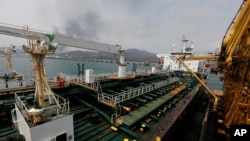Global oil prices spiked following Israel’s surprise air strikes on Iranian nuclear and military facilities.
As of late June 13, futures for the benchmark Brent blend were up more than 7 percent over the previous day, and up 12.5 percent compared to a week earlier.
U.S. West Texas Intermediate crude, meanwhile, finished up 7.62 percent—13 percent higher than a week ago.
Both blends had their largest intraday moves since 2022 when Russia launched its full-scale invasion of Ukraine.
A member of the Organization of the Petroleum Exporting Countries, Iran currently produces around 3.3 million barrels per day, and exports over 2 million barrels daily of oil and fuel.
Israel has not yet hit Iran’s oil infrastructure, but there are growing fears it will if tensions escalate further.
Iran has also made veiled threats about disrupting oil tanker traffic via the Strait of Hormuz, a vital shipping passage: Saudi Arabia, Kuwait, and Iraq, as well as Iran, rely on the narrow waterway to get their oil to China and other global markets.
About a fifth of the world's total oil consumption passes through the strait.
Among those warning of the political dangers of soaring oil prices are Ukrainian President Volodymyr Zelenskyy who said Russia, which relies heavily on global oil revenues to power its war economy.
“The strikes led to a sharp increase in the price of oil, which is negative for us,” Zelenskyy said. “The Russians are getting stronger due to greater income from oil exports.”








